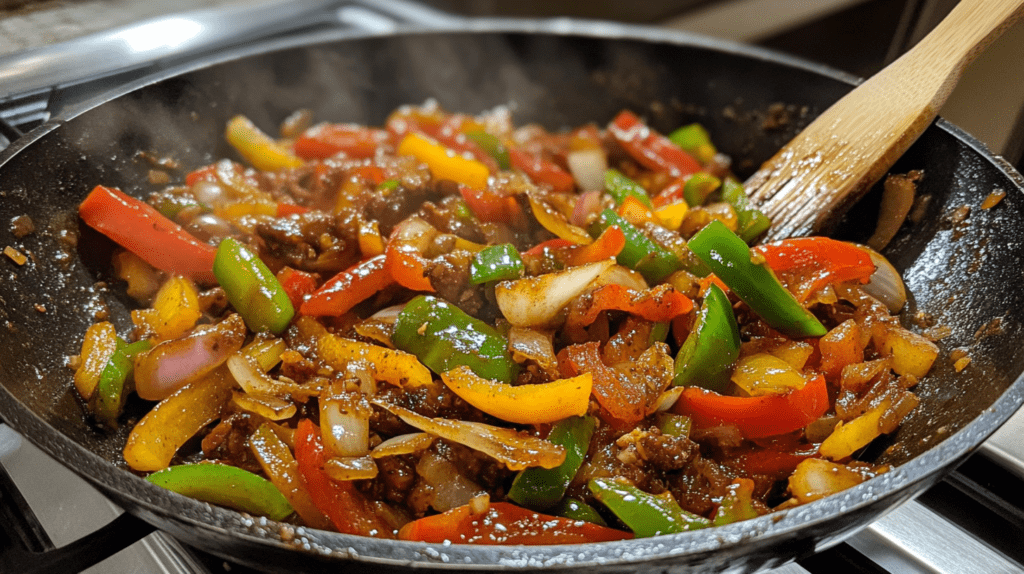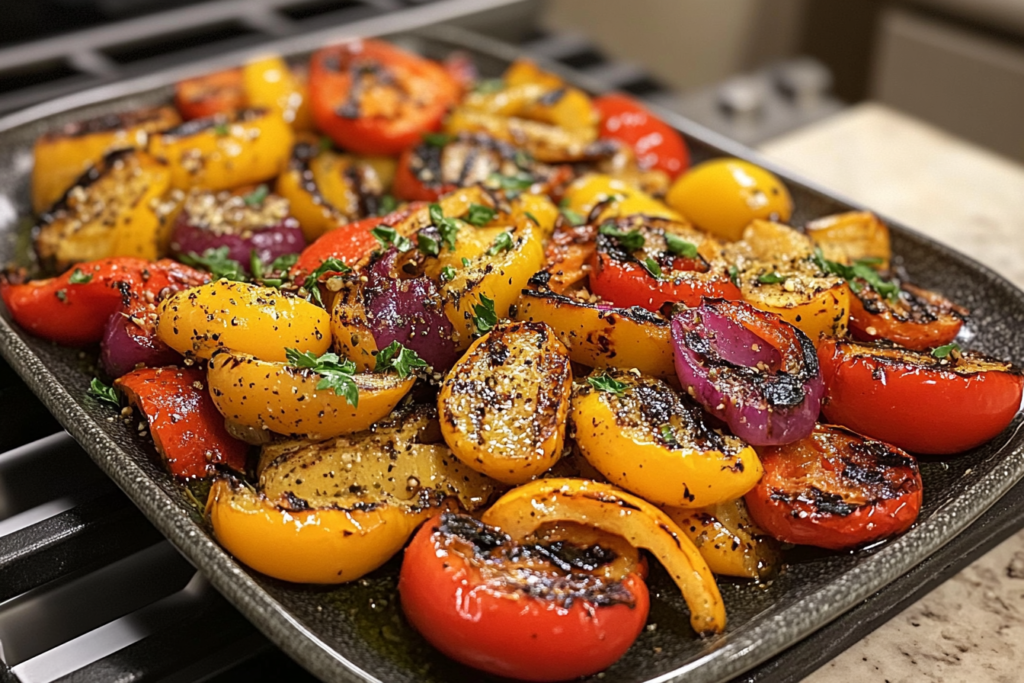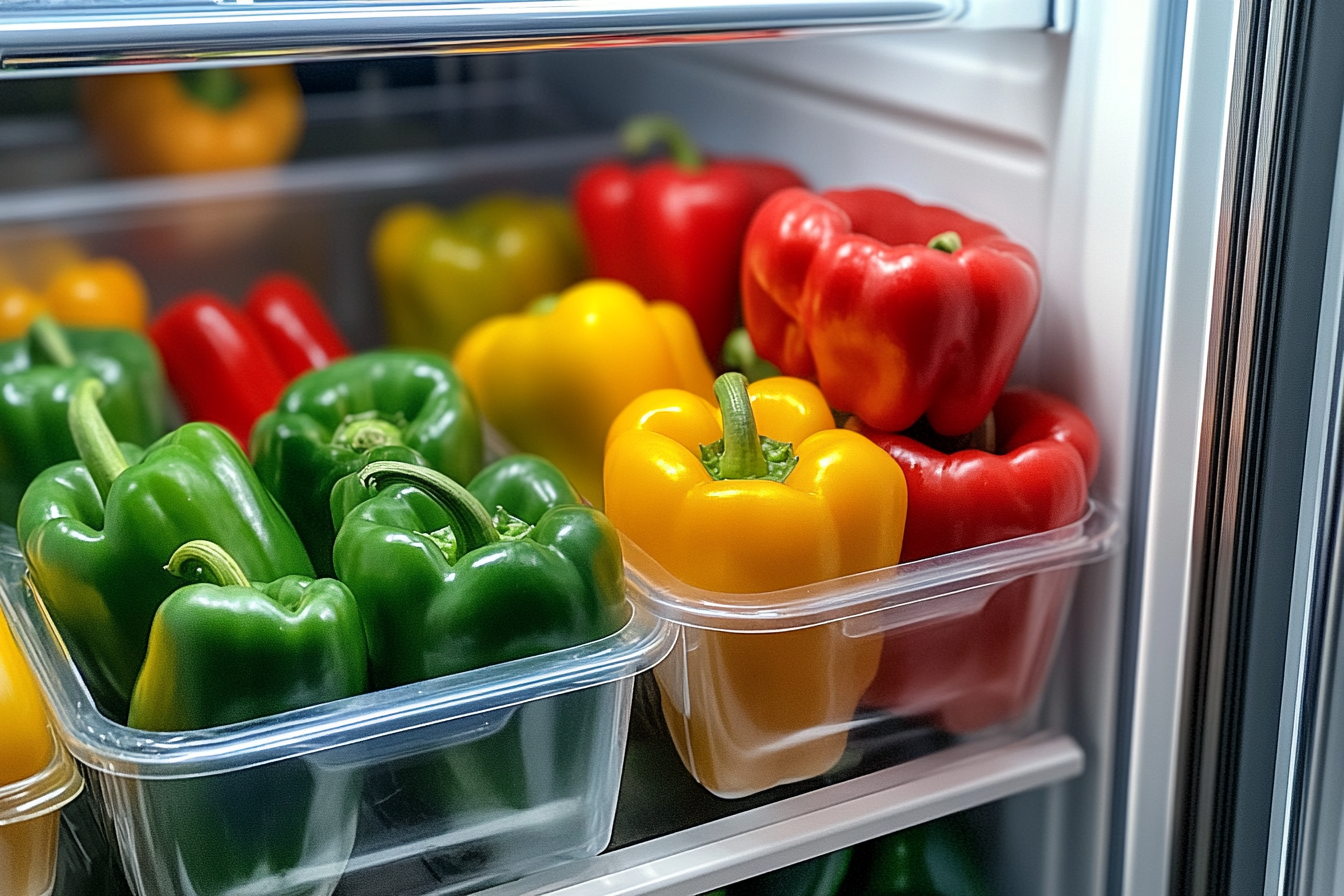How to keep peppers from getting soggy? Peppers are a versatile and colorful addition to meals, whether they’re raw, roasted, stir-fried, or pickled. However, nothing dampens their appeal more than sogginess. In this article, you’ll discover foolproof techniques to preserve the crunch and freshness of peppers. From choosing the right peppers to storing and cooking them the correct way, we’ll cover every essential detail. With these tips, your peppers will stay crisp and perfect for any recipe. Let’s dive in!
Understanding Why Peppers Get Soggy
Natural Moisture Content of Peppers
Peppers, like many fresh vegetables, naturally contain a high percentage of water. This moisture is what gives them their plump, juicy texture. However, if not handled properly, this very water content can cause them to soften or turn mushy over time. The cell walls of peppers degrade when exposed to certain conditions, releasing their natural juices.
Environmental Factors
The environment plays a significant role in whether your peppers stay fresh or not. High humidity levels can accelerate the spoilage process by encouraging mold or soft spots. Similarly, exposure to fluctuating temperatures can cause condensation inside storage containers, leading to sogginess. Ever noticed how peppers left on a sunny counter become limp? That’s because heat causes them to lose water rapidly.
Common Mistakes in Storage and Preparation
Mistakes in storing and prepping peppers can spell disaster for their crunch. For instance, washing peppers before storage introduces excess moisture, which speeds up spoilage. Additionally, storing peppers in airtight containers without proper airflow traps moisture, effectively turning them into a soggy mess. Improper preparation methods, like cutting peppers long before you need them, also leave them vulnerable to losing texture.
By understanding these factors, you’re already one step closer to keeping peppers from getting soggy. But don’t worry; we’ve got detailed solutions ahead to make sure your peppers remain firm and flavorful.
Best Practices for Preventing Sogginess
Proper Storage Techniques
Storing peppers correctly is the first line of defense against sogginess. Start by ensuring the peppers are dry before putting them away. Washing them in advance, though well-intentioned, introduces excess moisture that accelerates spoilage. Instead, only wash peppers right before use.
Refrigeration Guidelines
Refrigeration is key to keeping peppers fresh. Place them in the crisper drawer of your refrigerator, where the humidity level is controlled. To maintain optimal freshness, use ventilated containers or perforated plastic bags that allow air circulation. Avoid using airtight bags; they trap moisture, which can cause peppers to sweat and lose their crunch.
Use of Ventilated Containers
A simple tip? Use containers specifically designed for vegetable storage. These containers often feature vents or moisture-control technology to keep vegetables like peppers crisp for longer. For an eco-friendly option, try wrapping peppers in paper towels and storing them in a breathable bag.
Choosing Fresh Peppers
The journey to crisp peppers begins at the grocery store. Selecting high-quality peppers ensures a longer shelf life and better texture during cooking.
Signs of Freshness
When picking peppers, look for firm, glossy skin that’s free of wrinkles or soft spots. The stems should be green and sturdy, indicating freshness. Avoid peppers with blemishes, as they can spoil faster.
Seasonal Considerations
Peppers are at their best when purchased in season. During peak months, they’re more likely to be fresh, flavorful, and less prone to sogginess. Locally grown peppers are also a great choice, as they haven’t endured long shipping processes that can compromise texture.
Preparing Peppers Correctly
Preparation matters just as much as storage. How you handle peppers before they hit the pan—or the plate—can make all the difference.
Washing Methods That Prevent Water Retention
When washing peppers, use a quick rinse under cold water. Avoid soaking them for extended periods, as they can absorb excess moisture. After washing, pat them dry thoroughly with a clean kitchen towel or paper towel to remove any lingering water.
Cutting and Sealing Tips
Cutting peppers releases moisture, so it’s best to prepare them only when needed. If you must cut them in advance, store them in a sealed container lined with a dry paper towel to absorb excess moisture. Keep the slices uniform for even cooking and better texture retention.
By following these best practices, you’ll set the stage for perfectly crisp and fresh peppers. Whether you’re storing them or preparing them for a recipe, these tips will help ensure their crunch remains intact.
Cooking Tips to Retain Crunchiness
High-Heat Cooking Methods
Cooking peppers over high heat is one of the best ways to retain their natural crunch. Methods like stir-frying, roasting, and grilling work wonders for preserving their texture. High heat cooks the exterior quickly, locking in the moisture and avoiding the limp, soggy results you’d get with slow, wet cooking techniques.
Stir-Frying for Quick Results
Stir-frying peppers over high heat ensures even cooking without overdoing it. Use a wok or a large skillet, and toss sliced peppers with a small amount of oil. Keep them moving to avoid overcooking and maintain that signature crunch. Pro tip: add peppers toward the end of the stir-fry process to prevent them from becoming too soft.
Baking Without Overloading Moisture
When baking stuffed peppers or roasting them as a side dish, avoid adding too much liquid to the recipe. Excess moisture during baking can leach into the peppers, leaving them soggy. For stuffed peppers, drain any water released during cooking by slightly tipping the dish or using a baster.
Incorporating Peppers into Soups and Stews
While soups and stews naturally involve liquid, peppers don’t have to lose their crunch. Add them toward the end of the cooking process to keep their texture intact. Just a few minutes in simmering broth or sauce is enough to soften the skin slightly while preserving their firm bite.
Grilling for Smoky, Firm Peppers
Grilling peppers not only enhances their flavor but also maintains their firmness. Slice the peppers into large pieces, brush them lightly with olive oil, and place them on a hot grill. Cook for a few minutes per side until they have a slight char but remain crisp. This technique works well for bell peppers as well as thinner varieties like banana peppers.
By choosing the right cooking methods, you can ensure your peppers shine in every dish. Whether you’re roasting them to perfection or tossing them into a stir-fry, these tips make it easy to keep peppers from getting soggy.
Recipes That Keep Peppers Firm
Fresh Salad Recipes
Peppers shine in salads where their natural crunch can take center stage. Here’s a vibrant and easy-to-make recipe that highlights their texture:
Mediterranean Pepper Salad
Ingredients
- 2 red bell peppers, thinly sliced
- 2 yellow bell peppers, thinly sliced
- 1 cucumber, diced
- 1/2 red onion, thinly sliced
- 1/4 cup feta cheese, crumbled
- 2 tbsp olive oil
- 1 tbsp lemon juice
- 1 tsp dried oregano
- Salt and pepper to taste
Instructions
- Combine the sliced peppers, cucumber, and red onion in a large salad bowl.
- In a small bowl, whisk together olive oil, lemon juice, oregano, salt, and pepper.
- Drizzle the dressing over the vegetables and toss well to coat.
- Sprinkle crumbled feta cheese on top and serve immediately for the freshest taste and crunch.

Pickling Peppers
Pickling is an excellent way to preserve peppers while maintaining their bite. Follow this step-by-step guide for crunchy pickled peppers.
Ingredients
- 1 lb mixed peppers (sliced or whole)
- 2 cups white vinegar
- 1 cup water
- 2 tbsp sugar
- 1 tbsp salt
- 2 cloves garlic, peeled
- 1 tsp black peppercorns
- 1 tsp mustard seeds
Instructions
- Sterilize a large glass jar by washing it thoroughly and rinsing it with boiling water.
- Combine vinegar, water, sugar, and salt in a saucepan. Bring the mixture to a boil, stirring until the sugar and salt dissolve.
- Pack the peppers, garlic, peppercorns, and mustard seeds tightly into the sterilized jar.
- Pour the hot pickling liquid over the peppers, ensuring they’re fully submerged.
- Seal the jar with a lid and let it cool to room temperature before storing it in the fridge.
- Allow the peppers to pickle for at least 24 hours before enjoying their firm, tangy flavor.
Grilled Pepper Dishes
Grilled peppers are a simple yet satisfying option for side dishes or appetizers. The slight char on the skin adds depth while keeping the insides crisp.
Grilled Pepper Platter
Ingredients
- 3 large bell peppers (red, yellow, and green), halved and deseeded
- 2 tbsp olive oil
- 1 tsp garlic powder
- 1 tsp smoked paprika
- Salt and pepper to taste
Instructions
- Preheat your grill to medium-high heat.
- Brush both sides of the pepper halves with olive oil, then sprinkle with garlic powder, smoked paprika, salt, and pepper.
- Place the peppers cut-side down on the grill and cook for 3–4 minutes per side until they develop a light char.
- Serve immediately as a side dish, or chop and use as a topping for grilled meats or pasta.

Nutritional Content
Peppers are a healthy addition to any meal. Here’s the nutritional breakdown per 100g of raw peppers:
| Nutrient | Amount |
|---|---|
| Calories | 31 |
| Protein | 1g |
| Fat | 0.3g |
| Carbohydrates | 6g |
| Fiber | 2g |
| Vitamin C | 127mg |
| Vitamin A | 3131 IU |
Avoiding Common Mistakes
Overcrowding Peppers in Storage
One of the most common errors people make when storing peppers is overcrowding them. Piling too many peppers in a single container or crisper drawer limits air circulation, causing condensation to build up. This trapped moisture creates the perfect environment for sogginess. To prevent this, store peppers in a single layer or use ventilated storage containers that promote airflow. If you’re short on space, consider using a second container or wrapping them individually in paper towels to absorb excess moisture.
Freezing Peppers Without Blanching
Freezing is a great way to extend the shelf life of peppers, but skipping the blanching step can lead to a mushy texture when thawed. Blanching peppers briefly in boiling water helps lock in their firmness by halting enzymatic activity. After blanching, pat the peppers completely dry and flash-freeze them on a baking sheet before transferring them to an airtight freezer bag. This method minimizes ice crystal formation, which is the main culprit behind soggy peppers post-thaw.
Storing Peppers With High-Moisture Foodshh
Storing peppers alongside other high-moisture vegetables like cucumbers or tomatoes can accelerate sogginess. These vegetables release moisture over time, which can seep into the peppers. To avoid this, keep peppers in their own designated space within the refrigerator. This not only keeps them fresh but also prevents cross-contamination of flavors.
Handling Cut Peppers Improperly
Cutting peppers in advance can save time, but improper handling will compromise their texture. If you must prepare peppers ahead of time, ensure they’re stored correctly. Place them in an airtight container lined with a dry paper towel to absorb any released moisture. Change the paper towel every day to maintain dryness, and always use cut peppers within two to three days for the best results.
Avoid Excess Water During Cooking
When cooking peppers, using too much water in the recipe can make them soggy. Steer clear of boiling peppers unless the recipe specifically calls for it. Instead, opt for dry heat methods like grilling or roasting, as these retain their natural crispness. If you’re using peppers in a sauce or soup, add them at the final stages of cooking to avoid over-softening.
By avoiding these common pitfalls, you can keep your peppers firm, flavorful, and perfect for any meal. Awareness of these details will save you from frustration and wasted produce.
Sustainable Tips for Preserving Peppers
Vacuum Sealing for Long-Term Storage
Vacuum sealing is an excellent way to preserve the texture and flavor of peppers while extending their shelf life. By removing air from the storage bag, you minimize the risk of moisture buildup and slow down spoilage. This method works particularly well for fresh, cut, or blanched peppers that you plan to freeze.
Steps for Vacuum Sealing Peppers:
- Wash and dry the peppers thoroughly.
- Slice or chop them into your desired size, or leave them whole if preferred.
- Place the peppers in a vacuum-sealable bag, ensuring they’re evenly spread out.
- Use a vacuum sealer to remove the air and seal the bag.
- Label the bag with the date and store it in the freezer for up to a year.
Drying Peppers as an Alternative
Drying peppers is a sustainable and energy-efficient way to keep them usable for months. Dried peppers retain their flavor and can be rehydrated for cooking or ground into pepper flakes or powder.
How to Dry Peppers at Home:
- Air-Drying Method: String peppers together using a needle and thread, then hang them in a warm, well-ventilated area. Allow them to dry naturally for 2–3 weeks.
- Dehydrator Method: Slice peppers into uniform strips and place them on the dehydrator tray. Dry them at 125°F (52°C) for 6–8 hours, checking periodically for dryness.
- Oven Method: Spread sliced peppers on a baking sheet and bake at the lowest setting (around 150°F or 65°C) for several hours until they’re completely dry.
Store dried peppers in airtight containers in a cool, dark place. They’ll last for months and remain a flavorful addition to soups, stews, and seasoning blends.
Making Pepper Powders at Home
For an added twist, you can transform dried peppers into homemade pepper powders. This is a fantastic way to preserve their flavor and keep your spice rack stocked with fresh, homemade seasonings.
Steps to Make Pepper Powder:
- Once peppers are fully dried, place them in a blender or food processor.
- Pulse until they reach your desired consistency, whether fine powder or coarser flakes.
- Transfer the powder into a spice jar or airtight container.
- Store in a cool, dry place, and use within 6 months for maximum flavor.
By adopting sustainable methods like vacuum sealing, drying, and making pepper powders, you can reduce waste while keeping peppers at their best. These techniques are not only practical but also eco-friendly, ensuring you enjoy peppers long after their peak season.
FAQs About Keeping Peppers from Getting Soggy
How do you store peppers after cutting?
To store cut peppers, place them in an airtight container lined with a dry paper towel. The paper towel absorbs any excess moisture, preventing the peppers from becoming soggy. Store the container in the refrigerator and use the peppers within two to three days for optimal freshness and crunch.
Can you freeze peppers without them getting mushy?
Yes, you can freeze peppers without them turning mushy by blanching them first. Blanching halts the enzymatic activity that can degrade their texture. After blanching, dry the peppers thoroughly, flash-freeze them on a baking sheet, and then store them in an airtight freezer bag.
What is the best way to reheat peppers without sogginess?
To reheat peppers while maintaining their texture, use dry heat methods like grilling, roasting, or pan-frying. Avoid microwaving peppers, as the steam generated during microwaving can make them soggy. A quick toss in a hot skillet is often the best option for reheating without losing their crunch.
Are certain pepper varieties less prone to sogginess?
Yes, certain varieties like bell peppers and poblano peppers are firmer and less prone to sogginess compared to thinner-skinned varieties like banana peppers or jalapeños. Choosing thicker-walled peppers can help maintain texture during storage and cooking.
Can soggy peppers be salvaged?
While soggy peppers lose their crispness, they can still be used in recipes where texture isn’t critical. Chop them up for soups, stews, or purees where their flavor will still shine. For a quick save, try roasting soggy peppers to concentrate their flavors.
What type of packaging works best for peppers?
Ventilated containers or perforated plastic bags are ideal for storing peppers. They allow proper airflow while preventing moisture buildup, which is key to keeping peppers firm. Avoid fully airtight bags unless you vacuum-seal them for freezing.
Conclusion and Final Tips
Keeping peppers from getting soggy may require some attention to detail, but the results are worth it. By selecting fresh peppers, storing them properly, and using cooking techniques that lock in their crunch, you can enjoy these vibrant vegetables at their best. Whether you’re adding them to a fresh salad or roasting them for dinner, these tips will ensure your peppers are always a standout ingredient. Experiment, have fun, and savor the difference a little care can make!


4 thoughts on “How to Keep Peppers from Getting Soggy: Expert Tips and Tricks”